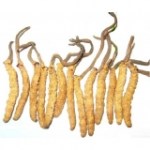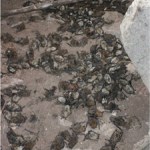fungus
Image source: Smithsonian Institution
You may recall prior Lifelines posts discussing the devastating effects of white nose syndrome (WNS) in bats. WNS, Pseudogymnoascus destructans is a fungus responsible for the deaths of millions of North American bats over the last ten years. In a new study published in the American Journal of Physiology - Regulatory, Integrative and Comparative Physiology, Dr. Craig Willis examined the effects of repeated arousals from hibernation induced by the fungal infection. Data from this new study provides evidence that infected animals do…
The blog post of mine that arguably "put me on the map" in the skeptical blogosphere was my very Insolent, very sarcastic deconstruction of Robert F. Kennedy, Jr.'s deceptive pseudoscience-ridden bit of fear mongering that he called Deadly Immunity. It was originally jointly published both by Salon.com and Rolling Stone, a blot that neither publication will ever overcome. At least Salon.com retracted the article over five years later. Rolling Stone never did, although the article is now available only to its paid subscribers.
The reason I mention this "past glory" (if you can call it that) is…
Scientists use a 'gene gun' to insert a gene from a flowering plant called rockcress into the cells of wheat seeds. The genetically modified wheat became more resistant to a fungus called take-all, which in real life can cause "a 40-60% reduction in wheat yields."
T-cells from six HIV+ patients were removed from their bodies, treated with a zinc-finger nuclease designed to snip a gene out of the cell's DNA, and put back in the patients. Removal of the gene mimics a naturally occurring mutation which confers resistance to the HIV virus. But only 25% of the treated cells showed…
One of the more bizarre bits of cancer quackery that I've come across is that of an Italian doctor (who, like many cancer quacks, appears not to be a board-certified oncologist) named Tullio Simoncini, who claims that cancer is really a fungus and has even written a book about it, entitled, appropriately enough for this particular quackery, Cancer Is A Fungus. The first time I encountered Simoncini, about five years ago, I was floored by his arguments, not because of how bizarre they were (although that was part of it) because of their sheer stupidity. Seriously, Simoncini's reasoning—if "…
You can't!
There's a fungus among us—a hundred different species in fact—and nearly all take up residence on our feet, according to a study that appears in the journal Nature this week.
Only a few fungi species were found on other body parts known to house fungi—such as behind the ears and on palms—according to the most thorough analysis to date of our fungal "landscape."
Ha. You're probably better off leaving most of them alone. Click through for the details.
_____
Other posts of interest:
How to get rid of spiders in your house
Why is your poop green?
How many cells are there in the…
Caterpillars with fungus growing out of their heads. Image of Cordyceps sinensis fungus from http://cordyceps-sinensis-mushroom.blogspot.com/
Whoever thought that a brain-attacking fungus might actually be good for you? This particular type of fungus, cordyceps, is known for attacking and killing caterpillars and can be found in the mountains of Tibet. Touted as a cure for various ailments including cancer, asthma, and erectile dysfunction, it is sold in Chinese markets as the "golden worm" or "Tibetan mushroom" for as much as $50,000 per pound! A new study published in RNA provides some…
Let's travel back in time fifteen years.
It's a time that, for me, at times seems as though it were just yesterday while at other times it seems like truly ancient history. Back then, certainly, I wasn't the blogging powerhouse that I am today. I didn't even know what blogging was because it was so much in its infancy that few people knew what it was. In fact, it was only around 14 years ago that I first discovered Usenet, that vast, sprawling, brawling assortment of discussion groups where I cut my skeptical teeth, so to speak, discovering, as I did, alt.revisionism (often abbrievated a.r.…
I hate to get all serious, but this is a topic near-and-dear to me, and one that needs more publicity. And while Zooillogix readers are intelligent and well-informed (and smoking hot, I might add), I want to be sure everyone is aware of the progress and potential of this epidemic. Plus, I know I'm not the only batfan here.
In February of 2006, a caver in eastern New York photographed a group of hibernating bats with an unusual white substance on their muzzles. The following winter, bats were noted flying outside of caves months before they typically come out of hibernation. Then there…
In Robert Louis Stevenson's classic story, Dr Henry Jekyll drinks a mysterious potion that transforms him from an upstanding citizen into the violent, murderous Edward Hyde. We might think that such an easy transformation would be confined to the pages of fiction, but a similar fate regularly befalls a common fungus called Fusarium oxysporum.
A team of scientists led by Li-Jun Ma and Charlotte van der Does have found that the fungus can swap four entire chromosomes form one individual to another. This package is the genetic equivalent of Stevenson's potion. It has everything a humble, Jekyll…
I did not expect everyone to nearly instantaneously solve yesterday's termite ball mystery. I'm either going to have to post more difficult challenges (from now on, nothing will be in focus!) or attract a slower class of reader.
Cuckoo fungus grows in a termite nest.
As you surmised, those little orange balls are an egg-mimicking fungus. It is related to free-living soil fungi, but this one has adopted a novel growth form that is similar in diameter, texture, and surface chemistry to the eggs of Reticulitermes termites. These hardened sclerotia are carried about the termite…
If I were to mention an ant-fungus mutualism- that is, an ecological partnership between an ant and a fungus that benefits both- most biologically literate people might think of the famed leafcutter ants and the edible mycelia they cultivate. But that is just one example.
Several other fungi have entered into productive relationships with ants, assisting especially in ant architecture. Consider:
Lasius umbratus walking in the galleries of an underground carton nest (Illinois)
A larger view of the same nest. The intricate galleries are made from fungal mycelia growing…
The Properties of Adaptive Walks in Evolving Populations of Fungus:
The rarity of beneficial mutations has frustrated efforts to develop a quantitative theory of adaptation. Recent models of adaptive walks, the sequential substitution of beneficial mutations by selection, make two compelling predictions: adaptive walks should be short, and fitness increases should become exponentially smaller as successive mutations fix. We estimated the number and fitness effects of beneficial mutations in each of 118 replicate lineages of Aspergillus nidulans evolving for approximately 800 generations at…
Hardly a natural history documentary goes by without some mention of leafcutter ants. So overexposed are these critters that I strongly suspect they're holding David Attenborough's relatives to ransom somewhere. But there is good reason for their fame - these charismatic insects are incredibly successful because of their skill as gardeners.
As their name suggests, the 41 species of leafcutter ants slice up leaves and carry them back to their nests in long columns of red and green. They don't eat the leaves - they use them to grow a fungus, and it's this crop that they feed on. It's an old…
Around 15,000 years ago, North American was home to a wide menagerie of giant mammals - mammoths and mastodons, giant ground sloths, camels, short-faced bears, American lions, dire wolves, and more. But by 10,000 years ago, these "megafauna" had been wiped out. Thirty-four entire genera went extinct, including every species that weighed over a tonne, leaving the bison as the continent's largest animal.
In trying to explain these extinctions, the scientific prosecution has examined suspects including early human hunters, climate change and even a meteor strike. But cracking the case has…
Wired Science reports on a way to bleach your hair without all issues of...you know...turning it so stiff and destroyed that it resembles a donkey tail. All you women of the world itching to turn blonde, take note.
The system involves an enzyme from forest fungus. Which is good somehow. Forest fungus on your hair being good apparently involves a meaning for the word "good" that I was not hitherto familiar with.
Not that it matters for me. The ongoing race about whether I will lose my hair entirely or whether it will turn entirely gray is a dead heat with both being the likely outcome.
Fun little stop-motion fungus vid this morning... which I can't get to run on here properly.
While I'm at it, I might as well add a video from a couple weeks back that appeared on Carl Zimmer's blog, The Loom. Entitled "Fungus Cannon," it demonstrates new research by Nicholas Money, a mycologist from Miami University, that fungus achieve the fastest known flight times in nature. These spores are launched at up to 55 miles an hour-which translates to an acceleration of 180,000 g. For more details check out Zimmer's post or the published research in PLoS One. The video is set to Anvil Chorus…
tags: bats, little brown bats, Indiana bats, white nose syndrome, cavers, Alan Hicks
Hibernating bats suffering from the mysterious "White Nose Syndrome" (arrows).
Image: Alan Hicks, NYS Department of Environmental Conservation [larger view]
If you live in New York or Vermont, then you might have heard about the mystery disease that is killing tens of thousands of bats hibernating in caves and mines throughout these two states. The disease has been given the descriptive appellation, "white nose syndrome" because its most obvious symptom (besides death), is the peculiar ring of white fungus…
As many of you might have noticed, Benny and I have been off for the week for Christmas in San Francisco. The plan was to visit the Zoo on Wednesday, which obviously did not happen, so we checked out the Monterey Bay Aquarium for a twelfth time. Anyway, our apologies for the lack of posts. We will pick up next week but we leave you with this piece, directly lifted from this Wired article.
Genetic engineering isn't just for scientists in ivory towers or corporate R&D labs anymore. Researchers are still creating new mice and crops every week, but the tools and knowledge necessary to create…
For over a century the nature of prototaxites has been a source of mystery and debate among scientists. Growing over 20 feet tall and a yard wide, the organism grew straight up like a tree trunk, but had no leaves or branches. Prototaxites fossils from between 420 and 350 million years ago have been found throughout the world. Speculation as to whether prototaxites was a lichen, algae or fungus has divided researchers since the first fossil was found over 100 years ago. After advanced chemical analysis, the verdict is finally in: prototaxites was a huge friggin fungus. University of Chicago…



